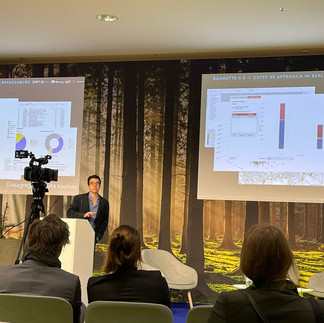Bauhütte 4.0 @ BAU 2023
- Bauhuette 4.0
- Mar 14, 2024
- 2 min read
Updated: Apr 9

Date: 17.04.2023 - 22.04.2023 Location: Baumesse, Munich Partners: TU Berlin Fraunhofer IPK CHORA Concious City CSFEP DiKieHo Land-Brandenburg Tegel Projekt Bauhütte 4.0 exhibited the latest alteration of an interactive value chain modeling in the Berlin-Brandenburg region. In order to achieve global and national climate targets and reduce environmental impacts from the extraction of primary construction raw materials, the field of housing and construction must be rethought and profoundly revolutionized. Bauhütte 4.0 creates the basis for efficient construction with wood on an urban scale to achieve CO2 targets on a regional, national, and European level and transform cities into CO2 reservoirs. The exhibition showed the progress of digitalization, networking, and standardization for a regional system of urban timber construction as well as for agile and ambidextrous design and execution processes.
Photos: CHORA Concious City
The BI platform is hosted online but accessible through an interface of four dashboards, and encompasses four different analysis scales: Overview (conceptual), Regional (forest), Architectural (building), and Urban (city).

Figure: Sebastián Orozco Muñoz
An initial overview landing page welcomes the user and describes the different phases of the value chain according to the ISO 14001 LCA standard. This serves to clarify which processes and activities are involved in the ‘forest to city’ transformation, and what is their average percentual contribution to carbon emissions or storage.
Afterwards, a regional scale forest surveying panel allows for the selection of a specific forest surface to track it´s most relevant information. A visual breakdown from total biomass to CLT yield is displayed in the dashboard as well as other relevant information, such as dominating tree species, organic content in the soil and environmental protection regime if applicable.
Further along the value chain, both the architectural and urban scale are accessible for exploration. The contents of the dashboard´s main window are scale-dependent, so that the user can also select specific buildings in the Schumacher Quartier, or specific Building parts, to see their material composition breakdown and their contribution in terms of carbon emissions, as well as other related KPIs. It allows the user to combine determined percentages of building typologies ranging from “present-day” to ambitious “70%+” wood-based prototypes. A series of KPI´s update instantly according to the user´s combination and presents the final carbon balance that could be achieved.
This type of hypothesis exploration method is meant to facilitate decision-making processes on a political-administrative level. Similar implementations of this analytical workflow can be applied to other German or European regions in order to discover new bio-based materials reservoirs and simulate the contribution of new forest-to-citiy Value Chains across the continent.















Comments